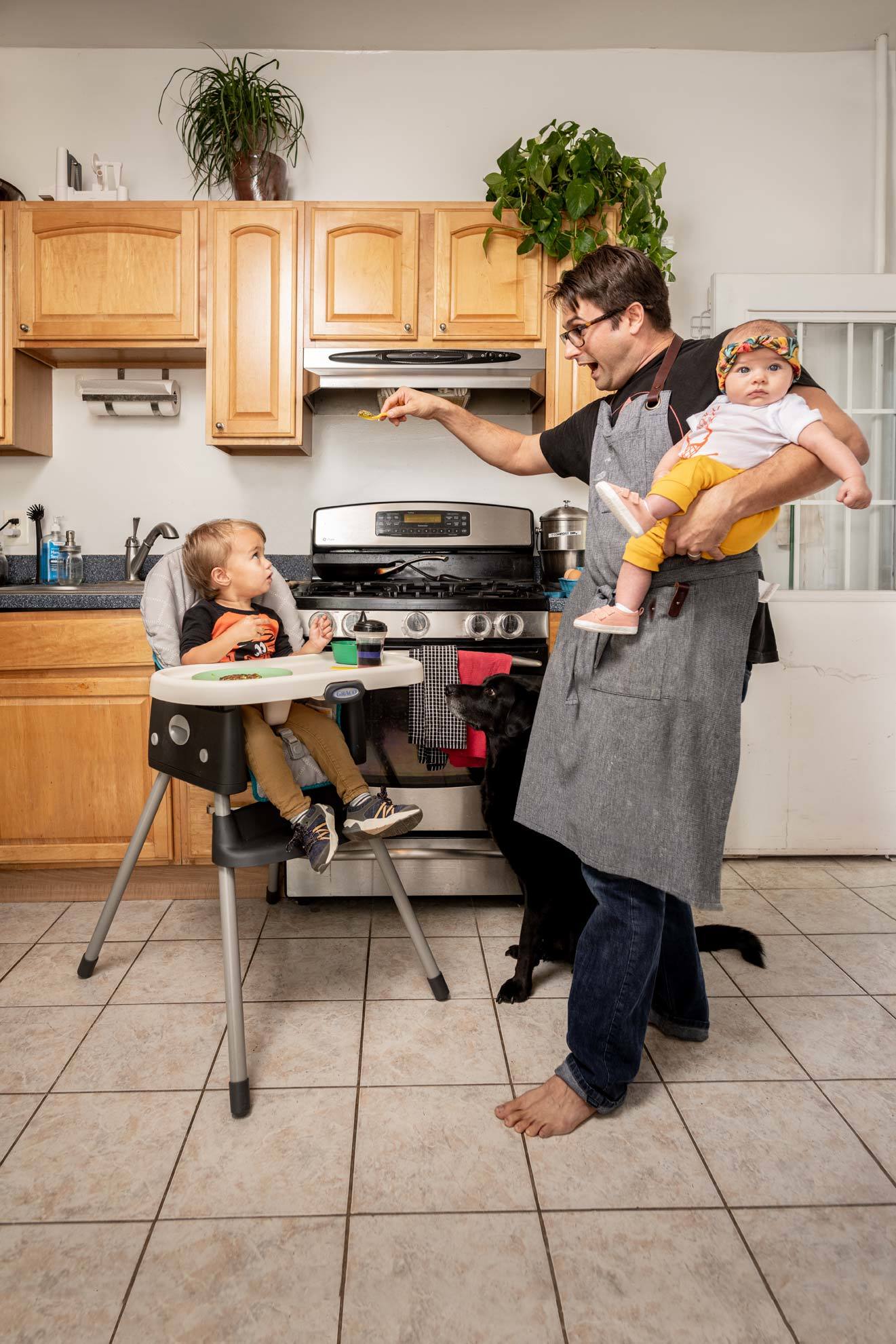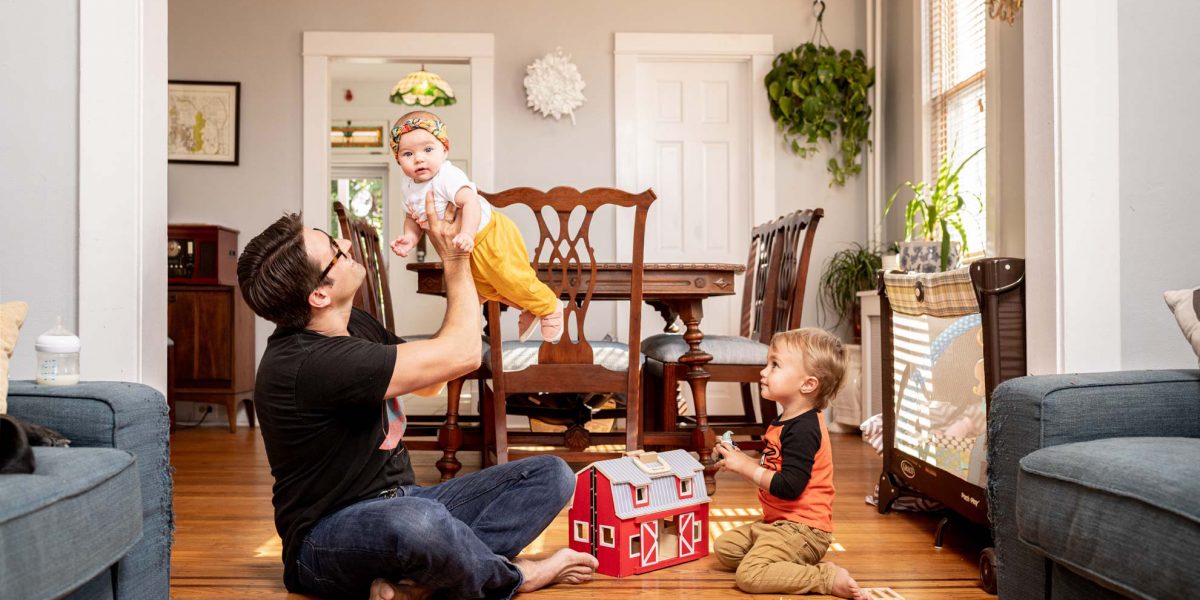Education & Family
Daddy Duty
Stay-at-home dads are on the rise—and redefining the role of fatherhood.
On an impossibly warm morning in late September, James Wolf has his hands full. Literally.
Sitting on an Orioles blanket at a Wyman Park playgroup, he bounces a toddler up and down on his left thigh, encouraging the familiar motions of “The Wheels on the Bus,” while his right arm rocks a stirring infant nestled inside her car seat. Somehow, and without upsetting the rhythm of either child, a cell phone emerges from his back pocket, which he deftly uses to capture a video to send to his wife. In between songs, he greets wandering toddlers by name and chats with the other 20 or so parents and caregivers—all of whom are women.
Sixteen miles north at GBMC-Hunt Valley, his wife, Dr. Kate Diehn, settles into her first full week back to work as a primary-care physician after the birth of their daughter, June, earlier in the summer. By the time she returns home in the evening, she’ll have cared for upward of 16 patients while her family spent their day visiting playgroups, running errands, taking long walks, and keeping the house in order.
Wolf and Diehn are part of a growing trend of couples who are bucking the antiquated gender norms that once kept women out of the boardroom and men out of the nursery. According to the Pew Research Center, 17 percent of all stay-at-home parents in 2016 were fathers—that’s a 10 percent rise since the data was first reliably gathered in 1989.
Wolf had very little hesitation about leaving his career as an environmental remediation senior project manager. His job was rewarding, he liked the work, and he has a master’s degree from Johns Hopkins in environmental science to boot, but the opportunity to stay home with his kids was an easy choice, especially given his wife’s higher earning potential.
“When our son, Henry, was born, we kicked around the idea of leaving my job, and the utility of having one of us at home was what tipped the scales,” says Wolf. “It pays off in so many dividends—the continuous exposure to the kids means there’s no disconnect. I know what they’ve learned and done all day and can relay that to my wife.”
But it doesn’t come without sacrifice.
Wolf cites the main stressors of being an at-home parent: the beating his body takes from holding and chasing around two small kids, the pressure on his wife to be the sole breadwinner, and the occasional feelings of isolation he has. Though the number of stay-at-home dads is certainly rising, it’s not always easy to break into a mom group.

Feeding time: James Wolf with Henry and June. –Mike Morgan
“Moms connect quickly because they typically have the shared experience of being pregnant, going through birth, and breastfeeding,” says Wolf. “I can’t really chime in on those, so I sometimes have to wait on the sidelines until I can jump in to talk about things like diapers or which libraries and playgrounds to go to.”
According to the Pew Research, 17 percent of all stay-at-home parents in 2016 were fathers.
WTMD music coordinator Sam Sessa also struggled with the isolation of parenting young children when he left his job as a Baltimore Sun reporter to stay home with his newborn son.
As a stay-at-home dad, it took some time to fall into a groove, and Sessa was surprised to find himself almost exclusively among mothers and female nannies. “I’d read stories that they existed, but, in practice, there just weren’t that many dads around,” he says. Like Wolf, Sessa noticed barriers to making meaningful conversation with some of the mothers. “Being a stay-at-home dad was isolating in ways I wasn’t expecting,” he says. “The first time I saw the acronym for the term, I was like, ‘Oh, of course it’s SAHD.’”
He and his wife, Dr. Amie Sessa, a dermatologist, synchronized their schedules so Sam could work two days a week at WTMD to ease the isolation. “In the early days of parenting, I would walk into the office, sit down next to a coworker, and say, ‘I need to talk to an adult for the next 15 minutes, please,’ which became my therapy after spending a full day with a baby and a toddler.”
It didn’t, however, take Sessa long to find a way to connect to his stay-at-home peers, and his part-time work actually became a lifeline (and, eventually, a full-time gig as his kids got older). At a library playdate, a group of moms noticed his WTMD shirt and lamented the loss of attending concerts after having kids. Immediately seeing a way to fill the void, this conversation sparked Sessa to create the popular Saturday Morning Tunes series, which brings kids and their parents—yes, even dads—to various venues around Baltimore for music the entire family can find palatable. He clearly struck a chord—a recent Saturday Morning Tunes concert at Power Plant Live! saw 1,200 men, women, and children rocking out.
And while Sessa’s music series is produced on a fairly large scale, Dr. Kevin Roy, an associate professor at University of Maryland’s School of Public Health, says that, as men and women renegotiate caregiving roles, it’s not uncommon for stay-at-home fathers to create their own social events and circles. “Men who stay at home can feel a need to play a community role,” he says. “Instead of feeling they are just caregivers, they might also be the soccer coach and get involved in community-based volunteer work as a way to create some status in their new role.”
It was this impulse, coupled with a very real need to connect with other male parents, that led to the creation of stay-at-home-dad groups around the country. Brock Lusch of Cincinnati is a board member of the At-Home Dad Network, a group with more than 13,000 Facebook followers, that was founded 24 years ago in an attempt to connect fathers to each other. Now the group hosts an annual convention.
“It started on chat rooms and forums, and at the first convention, they ordered pizza and brought in a few speakers,” says Lusch, who was in the midst of prepping for this year’s convention in Minneapolis, speaking by phone. DadCon19 will bring more than 120 men to Minnesota with the mission of connecting primary caregiver dads together to discuss professional development as dads, network, and get a chance to relax.
“Being a stay-at-home dad was isolating in ways I wasn’t expecting,” says Sam Sessa.
Mike Howarth, a Federal Hill father who left his job at Legg Mason to become a full-time parent at about the same time the At-Home Dad Network launched, remembers the world before social media, when men on the playground were sparse and there were no neighborhood Facebook pages to turn to for kid-friendly events.
“The ‘stay-at-home’ part of the title is a misnomer,” he says. “You have to get out of the house.” And so, he turned to what existed in 2000—phone chains, list serves, word of mouth, and the original way to build a network: physically going out into the world to meet people. “We lucked out, living in Federal Hill, because there were a lot of new, young families, and there was always something to do,” he says.
Tony Stephens, a Federal Hill father of two, has capitalized on the social media landscape not available to Howarth at the turn of the century. After moving his family from College Park to Baltimore, Stephens quickly realized the intense commute back to his work as a lobbyist was untenable. He took a 40 percent pay cut and began working 30 hours a week as the executive director of the Downtown Baltimore Family Alliance, a nonprofit that connects city parents to resources and each other. This move allowed him the flexibility to walk his boys to and from school, take the lead on household management, and find an easy way to connect to his new community.
But even the most evolved dads still deal with the stigma of not being the primary breadwinner. And while he certainly sees other fathers in the lead caregiving role, especially given his work, he thinks modern dads have less of a social stigma compared to their predecessors, who were viewed as doing “women’s work” by staying at home to raise children.
“Technology and social media have played a huge part—we can’t help but reflect our peers,” Stephens says. “I wondered how I would be perceived taking this step, but saw friends and acquaintances in New York, Iowa, lots of cities across the country doing this, and it gave me a nudge.”
Beyond that, Stephens says that social media has helped reshape gender norms. “Social media has changed the landscape of what we see as masculinity. We have access to more people like ourselves making choices that aren’t cookie-cutter masculine Mad Men images of what men are supposed to be.”
Even the most evolved dads still deal with the stigma of not being the primary breadwinner.
And the anti-Mad Men parallels don’t end there. “Family life is different now,” says Stephens. “Parents want to be engaged with their children. Most of us aren’t trying to work toward a lavish existence anymore. We just want to make a life where the family can be the best it can be.”
Dr. Roy echoes this sentiment. He says men who choose to stay at home tend to be younger, hold gender-equitable beliefs, and are able to realign their sense of what providing means. “These are men who are open to playing with different ways of being a guy,” he says. “They feel less stress taking on this role, which, to some extent, leads to a higher relationship quality with their partners.”
It’s worth noting that, of all the men interviewed for this article, not one regrets the decision to stay home. Each spoke reverently and generously about their wives. They all reported a sense of pride and feelings of fulfillment, and they all referenced the long-needed change in attitude toward “traditional” gender roles as even more motivation to stay home. “My wife is amazing,” says Wolf. “She takes care of her patients all day, which is exhausting. Then she comes home and transitions right back into the role of a parent, which is work all over again. She gives me a lot of credit for what I do for the family, but I think all the credit belongs to her.”
And though his wife, Diehn, struggles—like most working parents—with feelings of guilt and of missing out, she’s watched her young family thrive with her husband at the helm. “Sometimes I’m sad to not be the one at home, but I’m also proud that my kids can see that I’m dedicated to my career,” she says. “Ultimately, our arrangement enables me to be the best I can be at work, because I know my kids are being taken care of by someone who sees them and loves them like I do.”
Sessa believes the positive outcomes of fathers taking the lead reverberate far beyond the home.
“Maybe having more stay-at-home dads would be good for the world,” he says. “If and when they go back to work, they’ll have more empathy for women who are parents. The default mode for men can sometimes be ignorance—before dads stayed home, they didn’t know what women went through, because they hadn’t done it.”
